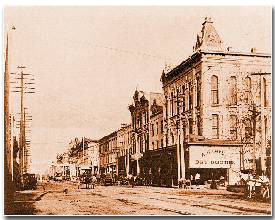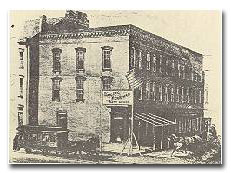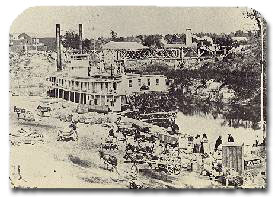YEARS OF WAR AND RECONSTRUCTION (1860-1870)
The national conflict reached the crisis stage in December, 1860, when South Carolina seceded from the Union, to be quickly followed by Mississippi, Florida, Alabama, Georgia, Louisiana, and Texas. Delegates from these seven seceding states met in February, 1861, in Montgomery, Alabama, to draft a Constitution for the Confederacy and to elect Jefferson Davis provisional President. During April and May, Virginia, Arkansas, Tennessee and North Carolina seceded. The Confederacy was then complete, with a population of 9,103,000, compared to the Union's 22,340,000. President Lincoln issued the Emancipation Proclamation to take effect January 1, 1863, and the die was cast.
The federal census of 1860 showed a national population of 31, 433,321, with Texas having a total of 604,215, an increase of 184 percent for the decade. The population for Houston was shown to be 4,845 an increase of 102 percent. Harris County reported 9,070, and although this was an increase of 94 percent in ten years, it dropped to 15th place among the counties of the state in population. Rusk County ranked first, with 15,215; and Harrison County third with 15,001.
 Because of his belief that the best interests of the Union, Sam Houston was deposed March 16, 1861, after the people had ratified secession over his protest on February 23rd. Even though little of the War between the States was fought on Texas soil, Texas contributed a great deal to the cause of the Confederacy east of the Mississippi. When Texas went to war, it was under the sixth flag to fly over the area, the other five being the French, Spanish, Mexican, Republic of Texas, and the United States. Divided loyalties separated families and friends, and during these agonizing years the wartime blockades choked commerce and slowed civic progress. But the Chamber of Commerce maintained its diligent efforts to keep commerce moving and to protect the young city from as many of the problems of the period of conflict as possible.
Because of his belief that the best interests of the Union, Sam Houston was deposed March 16, 1861, after the people had ratified secession over his protest on February 23rd. Even though little of the War between the States was fought on Texas soil, Texas contributed a great deal to the cause of the Confederacy east of the Mississippi. When Texas went to war, it was under the sixth flag to fly over the area, the other five being the French, Spanish, Mexican, Republic of Texas, and the United States. Divided loyalties separated families and friends, and during these agonizing years the wartime blockades choked commerce and slowed civic progress. But the Chamber of Commerce maintained its diligent efforts to keep commerce moving and to protect the young city from as many of the problems of the period of conflict as possible.
The shooting war came no closer to Houston than Galveston. The Texas coast was blockaded from the beginning of the war, and on October 4, 1862, Galveston was captured; but on January 1, 1863, Confederate forces under General John B. Magruder recaptured Galveston, attacking simultaneously by the land and sea. Later in the year, Lieutenant Dick Dowling commanded a force that successfully repulsed a federal attack at Sabine Pass. The last shot fired in the War between the States was at Palmito Ranch near Brownsville, May 13, 1865.
 After the surrender of the Confederacy was negotiated at Appomattox Court House on April 9, 1865, General Gordon Granger of the United States Army was placed in command of Texas, with A. J. Hamilton being appointed by President Andrew Johnson as governor. When he landed at Galveston on June 19, 1865, General Granger issued an order that "in accordance with a proclamation by the executive of the United States, all Negroes are free." This date has since been celebrated by Texas African Americans as "Emancipation Day," and is popularly referred to by them as "Juneteenth."
After the surrender of the Confederacy was negotiated at Appomattox Court House on April 9, 1865, General Gordon Granger of the United States Army was placed in command of Texas, with A. J. Hamilton being appointed by President Andrew Johnson as governor. When he landed at Galveston on June 19, 1865, General Granger issued an order that "in accordance with a proclamation by the executive of the United States, all Negroes are free." This date has since been celebrated by Texas African Americans as "Emancipation Day," and is popularly referred to by them as "Juneteenth."
The end of the war left economic devastation throughout Texas, and this situation was further aggravated by the federal government's imposition of four years of military rule, marked by depredations, injustices and humiliations which embittered Texans more than the war itself. The military dictatorship was followed by four more years of oppressive rule under the administration of Governor E. J. Davis, who held the office for a second term without re-election. Even at the end of this period, after he was defeated at the polls, he refused to vacate the office of governor until President U.S. Grant denied his petition for federal troops and advised him to vacate.
The Texas Legislature, on September 25, 1866, incorporated the Texas Transportation Company, with Colonel John T. Brady as president, and W. P. Hamblen as secretary. A few years later, the line came into the hands of a debt, and it is now a part of the Southern Pacific System.
 Yellow fever struck Houston again in 1867, but determined civic leaders continued their development plans. The Houston Ship Channel Company was organized in 1869 to dredge Buffalo Bayou to the depth of nine feet, with additional dredging at the foot of Main Street to enable ships to turn around. A score of brick buildings created a modest skyline, and some additional streets were shelled. Alabama-Coushatta Indians supplied wild game to the local markets, cows were butchered in the city and hogs were driven through the streets to the sausage factory. Flies buzzed raw buffalo hides on the Central Railroad siding.
Yellow fever struck Houston again in 1867, but determined civic leaders continued their development plans. The Houston Ship Channel Company was organized in 1869 to dredge Buffalo Bayou to the depth of nine feet, with additional dredging at the foot of Main Street to enable ships to turn around. A score of brick buildings created a modest skyline, and some additional streets were shelled. Alabama-Coushatta Indians supplied wild game to the local markets, cows were butchered in the city and hogs were driven through the streets to the sausage factory. Flies buzzed raw buffalo hides on the Central Railroad siding.
The Social amenities, however, were not neglected. Violinist Charles Stone gave a concert, and the road company of "East Lynne" enjoyed a sellout. Fire companies conducted Calico Balls for Charity. Dick Dowling, hero of the Battle of Sabine Pass, got his Bank of Bacchus Saloon at the corner of Main and Congress Streets all lit up again. The city's first baseball team, " The Stonewalls." forerunner of the Buffs, the Colt .45's and the Astros, was organized, and the Jockey Club planned a fall racing season. By 1868, the first horse-cars carried men to work in the mornings and couples on moonlight excursions in the evenings. After Texas had ratified the 14th and 15th Amendments and was readmitted to the Union in February, 1870, Houston was ready to accelerate the rapid growth that had come in recent years.






